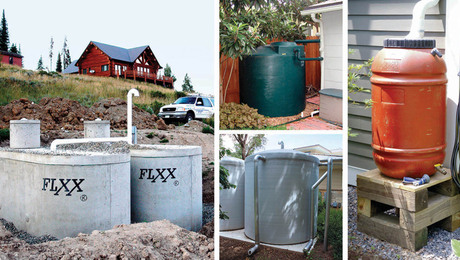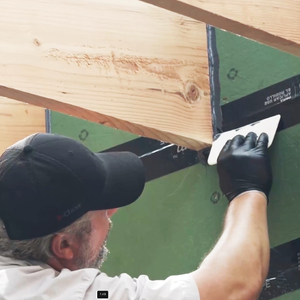We are replacing the siding on our circa 1875 balloon framed house in west Quebec,Canada. There is currently no insulation in the 2×6 walls. What I was thinking of doing is installing foil backed ISO panels (Energy Shield) underneath the new Canexel siding. The carpenter helping me with the Renovation thinks that any sort of impermeable or semipermeable rigid insulation on the outside of the house is a bad idea since it would trap any indoor moisture in the wall. He suggest opening up the wall and insulating the cavities from the outside, house wrap and then siding. I like the idea of rigid foam insulation on the exterior because there is no thermal bridging and missed un-insulated areas. Winters here by the way are long and cold. Any advice would be much appreciated.
Discussion Forum
Discussion Forum
Up Next
Video Shorts
Featured Story

There's a constant source of clean water for you to use, and all you have to do is collect it.
Featured Video
Builder’s Advocate: An Interview With ViewrailHighlights
"I have learned so much thanks to the searchable articles on the FHB website. I can confidently say that I expect to be a life-long subscriber." - M.K.

















Replies
2x6 walls ?
i'd blow the walls from the outside with cellulose, using a two or three hole blow
And in this case I agree.Wonder how close he is to Dino? You could make it a working vacation!;)
Welcome to the Taunton University of Knowledge FHB Campus at Breaktime. where ... Excellence is its own reward!
Mike,
I've read your replies and comments for a long time and
appreciate your opinons and knowledge.
That said, why choose cellulous over foam? I thought the
wood fiber would hold moisture and lead to decay?...
that's the arguement I've heard for foam.
Mclaren
well, 1st, it's a 2x6... so you lot's of depth
2d, if you put foam on , where will you put it .. on top of the sheathing , right ?
so ,what will you put in the wall cavity ?
if you are going to inject foam, then you will have to open each stud bay so they have access, they won't injuect it into the closed stud bays , or will they ?
so.. if all of the above is true.. then i'd take the cells in the stud bays over the foam sheets on top of the sheathing..... you'd STILL have to fill the stud bays with something .. what ? fiberglass ?... don't waste your money
nope ... this would be a no-brainer to meMike Smith Rhode Island : Design / Build / Repair / Restore
fair 'nuff.
I've just "heard" about cellulose holding moisture and causing rot.
Vs. foam as a vapor barrier, which causes it's own problems...
'preciate your input.
Mclaren
Nice to see a fellow canuck out here I am from new brunswick ( Y fait tu frette assez pour toi)
I would blow-in the wall cavities with cellulose from the outside by making holes with
a hole saw at the bottom, and every 48"or so, and top, and plug the holes as you go up the more holes the better because there could be all kinds of obstructions in there.
and as for rigid insulation a good cladmate on the outside would be advisable in order to eliminate any thermal bridges at the studs 1" minimum 1 1/2" preferable since you don't know if some spots will be entirely filled in. the cladmate or any Type 3 or 4 rigid insulation will let moisture trough unlike the Type 1&2 insulation like Dow's styrofoam SM. And under that Canexel make sure you put a strapping to create a air space so that the back side breaths. If you read the installation brochure you will see that if you don't do this they will not honour their warrantie.
Stay away from that foil faced rigid insulation unless you put it on the inside of your house which wouldn't be economical in your case. that stuff was designed for the lower united states where they are trying to keep the heat out of their houses we are the opposite here we try to keep it in. Aluminum is an excellent vapour barrier and the vapour barrier in our cold climates is always on the inside so if you use that on the exterior of your walls you will rot your house.
I also suggest that you consult an insulation specialist I know there is allot of those going around quebec they usually have these big trucks with all their sprayed urethane insulation equipment and cellulose blanket walls systems and all that good stuff, general contractors usually sub out to them. these guys take all kinds of energy efficiency courses and know how to do R-2000 homes so they are full of knowledge in this subject and insulating old houses is their specialty.
we tore open a old farm house near wakefield years ago and prior to starting owner told us to save the blown in insulation in the walls
out of the four walls we got about 2 bushel baskets of insulation . & he couldent believe it
the hpuse was ballon framed and you could drop a rock from the attic to the basement except at the windows so iguess he was taken for a ride
Thanks for the replies and sorry for the delay in responding ! I like the blow-in cellulose idea. As for the cladmate, I had a insulation contractor come and give me an estimate and he suggested that after the blowing of cellulose, to address thermal bridging, gaps in cellulose and, to act as a wind break that we spray the exterior of the house in a Polyurethane foam (Heatlok). Looks like pretty impressive stuff. It's made from recycled plastics and soya and is a zero ozone depletion substance.According to the contractor, any applied thickness under 1 1/2 inches does NOT act as a vapor barrier. Says it's expensive though. Have yet to receive estimate so I still don't know how expensive. Does anyone have any experience with this stuff ? Are there any alternatives out there ? How about Precision's idea of installing Cladmate ? Also, in response to Mike's post. What do you mean by 2 or 3 hole blow ? Is that 2 or 3 holes per bay ?Thanks again everyone !
i'd start with a two -hole blow.. one about 16" from the top of the bay & one about 16" from the bottom of the bay
AFTER i blew the first bay . i'd bore a hole in the middle of the bay and see what kind of compaction i was getting.. good compaction, i'd stick with the 2-hole
if the compaction was so-so, i'd switch to the 3-holeMike Smith Rhode Island : Design / Build / Repair / Restore
Right. Got it. Thanks !!
What about a vapour barrior? Does the celluose act as one? The importance of a V.B. has been drilled into me for years and having removed enough moldy f.g. batts over the years, I do tend to pay attention to it on my projects. My summer place is in southern Que. and I have half of the house insulated because I've been doing 1 room at a time, strip the drywall off the inside and go from there. Is there a better way?
> I would blow-in the wall cavities with cellulose from the outsideFirst make sure there's no K&T wiring in the walls.
So convenient a thing it is to be a reasonable Creature, since it enables one to find or make a Reason for everything one has a mind to do. --Benjamin Franklin